Surface Deformation from Sentinel-1A InSAR: Relation to Seasonal Groundwater Extraction and Rainfall in Central Taiwan
Abstract
1. Introduction
2. Data
2.1. SAR Dataset
2.2. GPS and Leveling Datasets
3. Method
4. Results
4.1. The GPS-calibrated InSAR Result from April 2016 to April 2017
4.2. Displacements in the Wet and Dry Seasons
4.3. Assessing the Calibrated InSAR Result by Leveling
5. Discussion
5.1. Land Subsidence in the Wet and Dry Seasons
5.2. Newly Identified Subsidence Spots in Yunlin by InSAR
5.3. Area of Significant Subsidence and Rainfall: The Potential of Hushan Reservoir in Reducing Land Subsidence
6. Conclusions
Author Contributions
Funding
Acknowledgments
Conflicts of Interest
References
- Galloway, D.L.; Burbey, T.J. Review: Regional land subsidence accompanying groundwater extraction. Hydrogeol. J. 2011, 19, 1459–1486. [Google Scholar] [CrossRef]
- Shiau, J.-T.; Huang, W.-H. Detecting distributional changes of annual rainfall indices in Taiwan using quantile regression. J. Hydro-Environ. Res. 2015, 9, 368–380. [Google Scholar] [CrossRef]
- Water Resource Agency, Ministry of Economic Affairs, R.O.C. Monitoring and Analyzing Subsidence of Changhua and Yunlin Area in 2017; Water Resource Agency, Ministry of Economic Affairs: Taipei, Taiwan, 2017; pp. 1–394.
- Hung, W.-C.; Hwang, C.; Chen, Y.-A.; Zhang, L.; Chen, K.-H.; Wei, S.-H.; Huang, D.-R.; Lin, S.-H. Land Subsidence in Chiayi, Taiwan, from Compaction Well, Leveling and ALOS/PALSAR: Aquaculture-Induced Relative Sea Level Rise. Remote Sens. 2017, 10, 40. [Google Scholar] [CrossRef]
- Hsieh, C.-S.; Shih, T.-Y.; Hu, J.-C.; Tung, H.; Huang, M.-H.; Angelier, J. Using differential SAR interferometry to map land subsidence: A case study in the Pingtung Plain of SW Taiwan. Nat. Hazards 2011, 58, 1311–1332. [Google Scholar] [CrossRef]
- Hung, W.-C.; Hwang, C.; Chen, Y.-A.; Chang, C.-P.; Yen, J.-Y.; Hooper, A.; Yang, C.-Y. Surface deformation from persistent scatterers SAR interferometry and fusion with leveling data: A case study over the Choushui River Alluvial Fan, Taiwan. Remote Sens. Environ. 2011, 115, 957–967. [Google Scholar] [CrossRef]
- Lu, C.-H.; Ni, C.-F.; Chang, C.-P.; Chen, Y.-A.; Yen, J.-Y. Geostatistical Data Fusion of Multiple Type Observations to Improve Land Subsidence Monitoring Resolution in the Choushui River Fluvial Plain, Taiwan. Terr. Atmos. Ocean. Sci. 2016, 27. [Google Scholar] [CrossRef]
- Huang, M.-H.; Bürgmann, R.; Hu, J.-C. Fifteen years of surface deformation in Western Taiwan: Insight from SAR interferometry. Tectonophysics 2016, 692, 252–264. [Google Scholar] [CrossRef]
- Hwang, C.; Hung, W.-C.; Liu, C.-H. Results of geodetic and geotechnical monitoring of subsidence for Taiwan High Speed Rail operation. Nat. Hazards 2008, 47, 1–16. [Google Scholar] [CrossRef]
- Tung, H.; Hu, J.-C. Assessments of serious anthropogenic land subsidence in Yunlin County of central Taiwan from 1996 to 1999 by Persistent Scatterers InSAR. Tectonophysics 2012, 578, 126–135. [Google Scholar] [CrossRef]
- Ge, L.; Ng, A.H.-M.; Du, Z.; Chen, H.-Y.; Li, X. Integrated space geodesy for mapping land deformation over Choushui River Fluvial Plain, Taiwan. Int. J. Remote Sens. 2017, 38, 6319–6345. [Google Scholar] [CrossRef]
- Amelung, F.C.; Galloway, D.L.; Bell, J.W.; Zebker, H.A.; Laczniak, R.J. Sensing the ups and downs of Las Vegas: InSAR reveals structural control of land subsidence and aquifer-system deformation. Geology 1999, 27, 483–486. [Google Scholar] [CrossRef]
- Senturk, S.; Cakir, Z.; Berk Ustundag, B. The potential of Sentinel-IA interferometric SAR data in monitoring of surface subsidence caused by overdrafting groundwater in agricultural areas. In Proceedings of the 2016 Fifth International Conference on Agro-Geoinformatics (Agro-Geoinformatics), Tianjin, China, 18–20 July 2016; pp. 1–4. [Google Scholar]
- Hung, W.-C.; Hwang, C.; Chang, C.-P.; Yen, J.-Y.; Liu, C.-H.; Yang, W.-H. Monitoring severe aquifer-system compaction and land subsidence in Taiwan using multiple sensors: Yunlin, the southern Choushui River Alluvial Fan. Environ. Earth Sci. 2010, 59, 1535–1548. [Google Scholar] [CrossRef]
- Sandwell, D.; Xu, X.; Mellors, R.; Wei, M.; Tong, X.; Wessel, P. GMTSAR: An InSAR Processing System Based on Generic Mapping Tools, 2nd ed.; Scripps Institution of Oceanography: San Diego, CA, USA, 2016. [Google Scholar]
- Zebker, H.A.; Chen, C.W. Phase Unwrapping for Large SAR Interferograms: Statistical Segmentation and Generalized Network Models. IEEE Trans. Geosci. Remote Sens. 2002, 40, 1709–1719. [Google Scholar]
- Berardino, P.; Fornaro, G.; Lanari, R.; Sansosti, E. A new algorithm for surface deformation monitoring based on small baseline differential SAR interferograms. IEEE Trans. Geosci. Remote Sens. 2002, 40, 2375–2383. [Google Scholar] [CrossRef]
- Hanssen, R. Radar Interferometry Data Interpretation and Error Analysis; Springer: Dordrecht, The Netherlands, 2001; Volume 2. [Google Scholar]
- Fattahi, H.; Amelung, F. InSAR uncertainty due to orbital errors. Geophys. J. Int. 2014, 199, 549–560. [Google Scholar] [CrossRef]
- Fuhrmann, T. Surface Displacements from Fusion of Geodetic Measurement Techniques Applied to the Upper Rhine Graben Area; Karlsruher Institut für Technologie (KIT): Karlsruhe, Germany, 2016. [Google Scholar]
- Kohlhase, A.O.; Feigl, K.L.; Massonnet, D. Applying differential InSAR to orbital dynamics: A new approach for estimating ERS trajectories. J. Geod. 2003, 77, 493–502. [Google Scholar] [CrossRef][Green Version]
- Bähr, H.; Hanssen, R.F. Reliable estimation of orbit errors in spaceborne SAR interferometry. J. Geod. 2012, 86, 1147–1164. [Google Scholar] [CrossRef]
- Massonnet, D.; Vadon, H. Ers-1 Internal Clock Drift Measured by Interferometry. IEEE Trans. Geosci. Remote Sens. 1995, 33, 401–408. [Google Scholar] [CrossRef]
- Bähr, H.; Hanssen, R.F. Network adjustment of orbit errors in SAR interferometry. In Proceedings of the Fringe 2009, Frascati, Italy, 30 November–4 December 2009. [Google Scholar]
- Biggs, J.; Wright, T.; Lu, Z.; Parsons, B. Multi-interferogram method for measuring interseismic deformation: Denali Fault, Alaska. Geophys. J. Int. 2007, 170, 1165–1179. [Google Scholar] [CrossRef]
- Catalão, J.; Nico, G.; Hanssen, R.; Catita, C. Integration of InSAR and GPS for vertical deformation monitoring: A case study in Faial and Pico islands. In Proceedings of the Fringe 2009, Frascati, Italy, 30 November–4 December 2009. [Google Scholar]
- Fuhrmann, T.; Caro Cuenca, M.; Knöpfler, A.; van Leijen, F.J.; Mayer, M.; Westerhaus, M.; Hanssen, R.F.; Heck, B. Estimation of small surface displacements in the Upper Rhine Graben area from a combined analysis of PS-InSAR, levelling and GNSS data. Geophys. J. Int. 2015, 203, 614–631. [Google Scholar] [CrossRef]
- Fuhrmann, T.; Garthwaite, M.C. Resolving Three-Dimensional Surface Motion with InSAR: Constraints from Multi-Geometry Data Fusion. Remote Sens. 2019, 11, 241. [Google Scholar] [CrossRef]
- Central Weather Bureau, Ministry of Transportation and Communications, R.O.C. CWB Observation Data Inquire System (CODis). Available online: http://e-service.cwb.gov.tw/HistoryDataQuery/index.jsp (accessed on 17 July 2019).
- Gabriel, A.K.; Goldstein, R.M.; Zebker, H.A. Mapping small elevation changes over large areas: Differential radar interferometry. J. Geophys. Res. Solid Earth 1989, 94, 9183–9191. [Google Scholar] [CrossRef]
- Tong, X.; Schmidt, D. Active movement of the Cascade landslide complex in Washington from a coherence-based InSAR time series method. Remote Sens. Environ. 2016, 186, 405–415. [Google Scholar] [CrossRef]
- Council of Agriculture, Executive Yuan, R.O.C. White Paper on Agricultural Irrigation; Council of Agriculture, Executive Yuan, R.O.C., Ed.; Council of Agriculture, Executive Yuan: Taipei, Taiwan, 2015; pp. 1–42.
- Center Region Water Resources Offices, Water Resource Agency; Ministry of Economic Affairs, R.O.C. Hushan Reservoir. Available online: http://www.wracb.gov.tw/mp.asp?mp=15 (accessed on 27 July 2019).
- Physical Sciences Division, N.E. El Niño Southern Oscillation (ENSO). Available online: https://www.esrl.noaa.gov/psd/enso/ (accessed on 31 July 2019).
- Borunda, A. El Niño, Explained. Available online: https://www.nationalgeographic.com/environment/weather/reference/el-nino-la-nina/ (accessed on 31 July 2019).

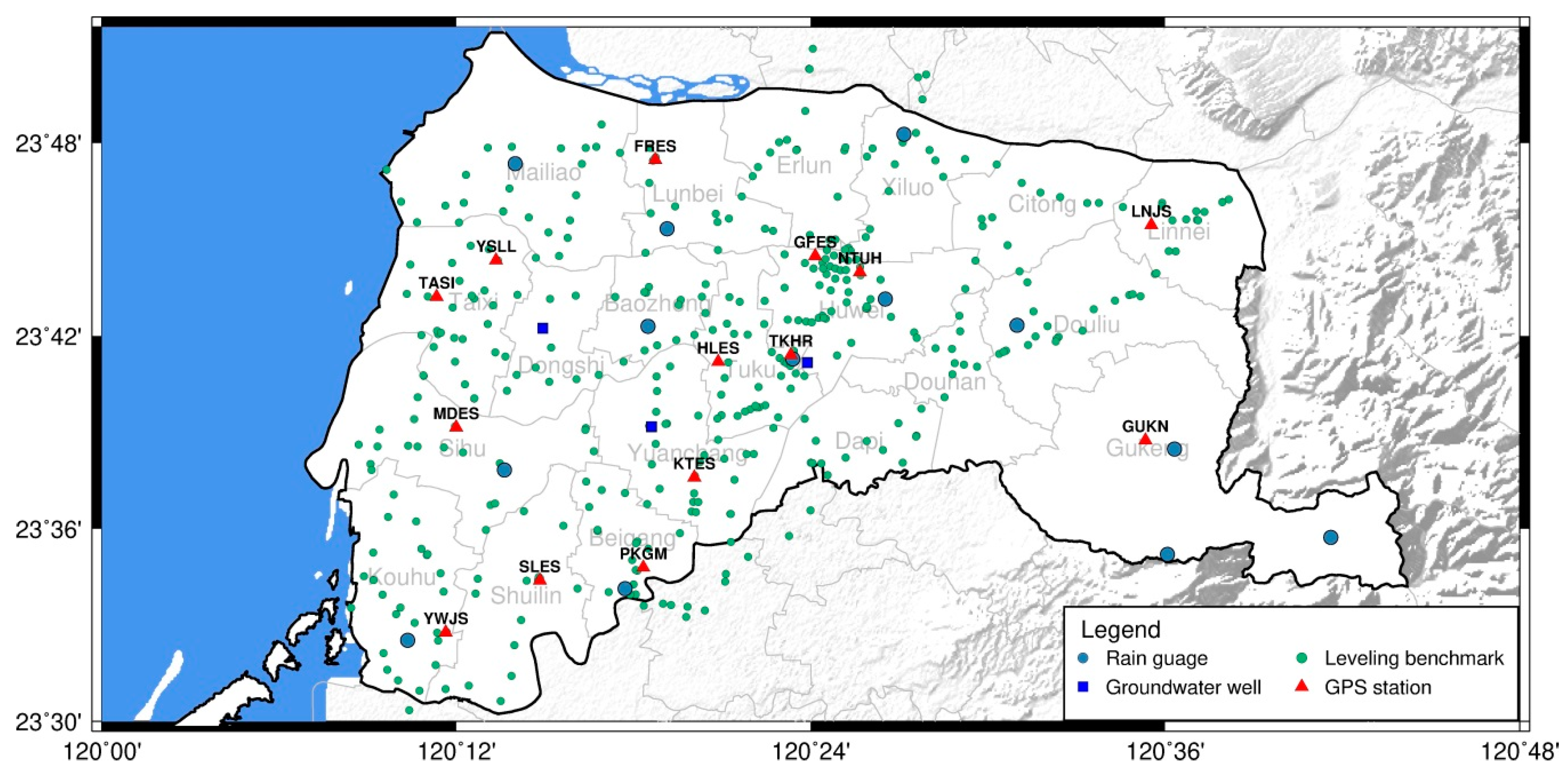
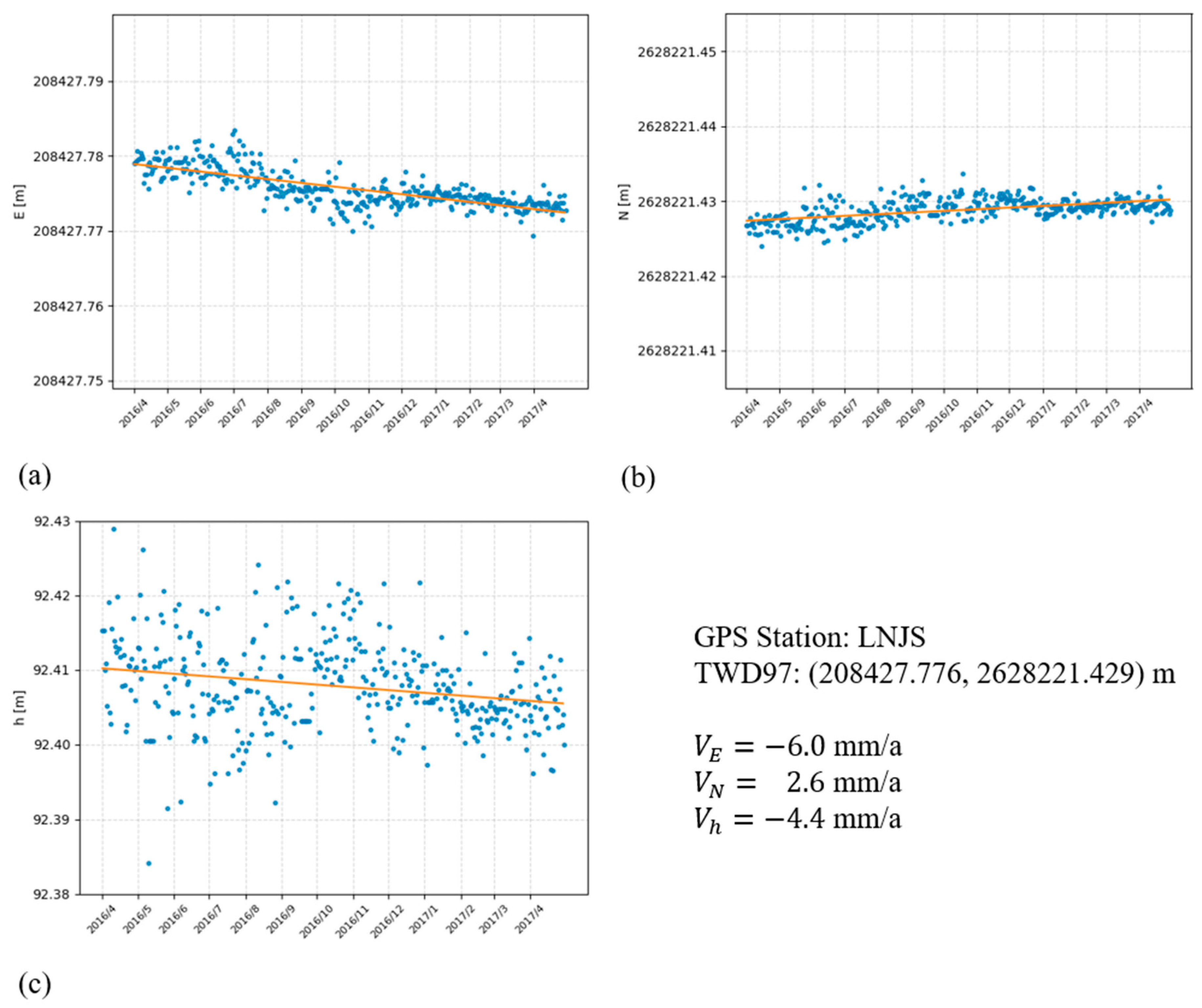
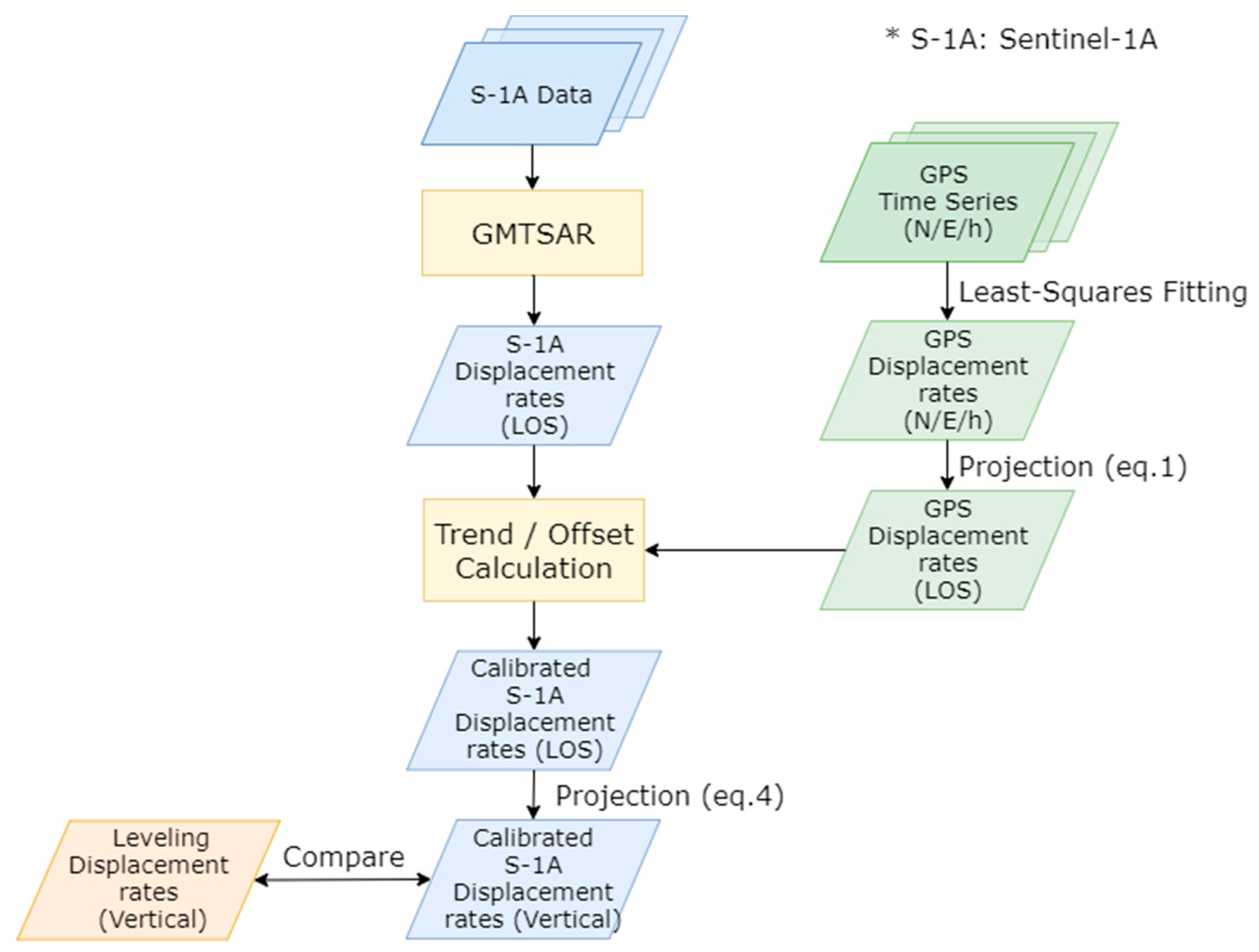
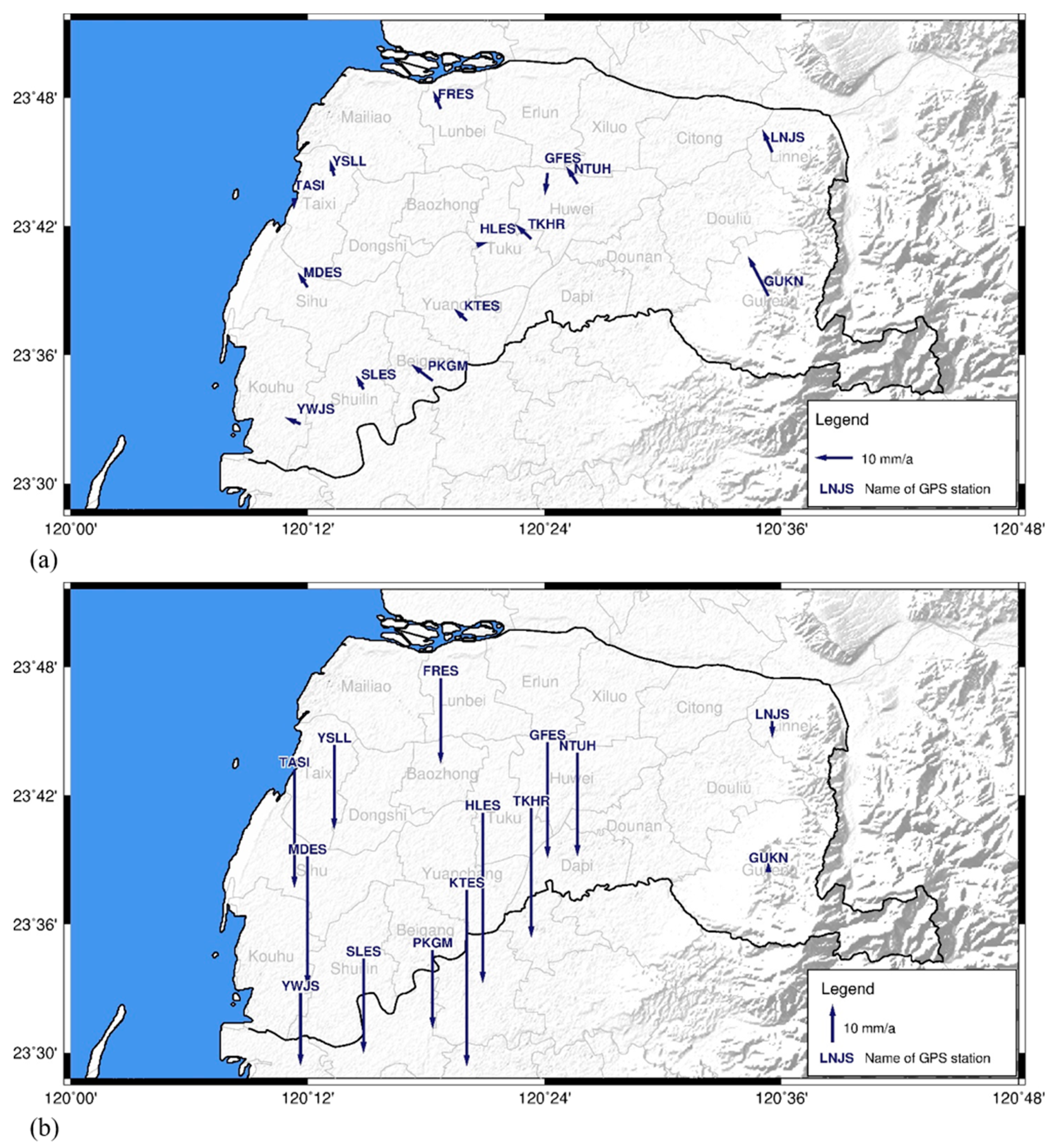
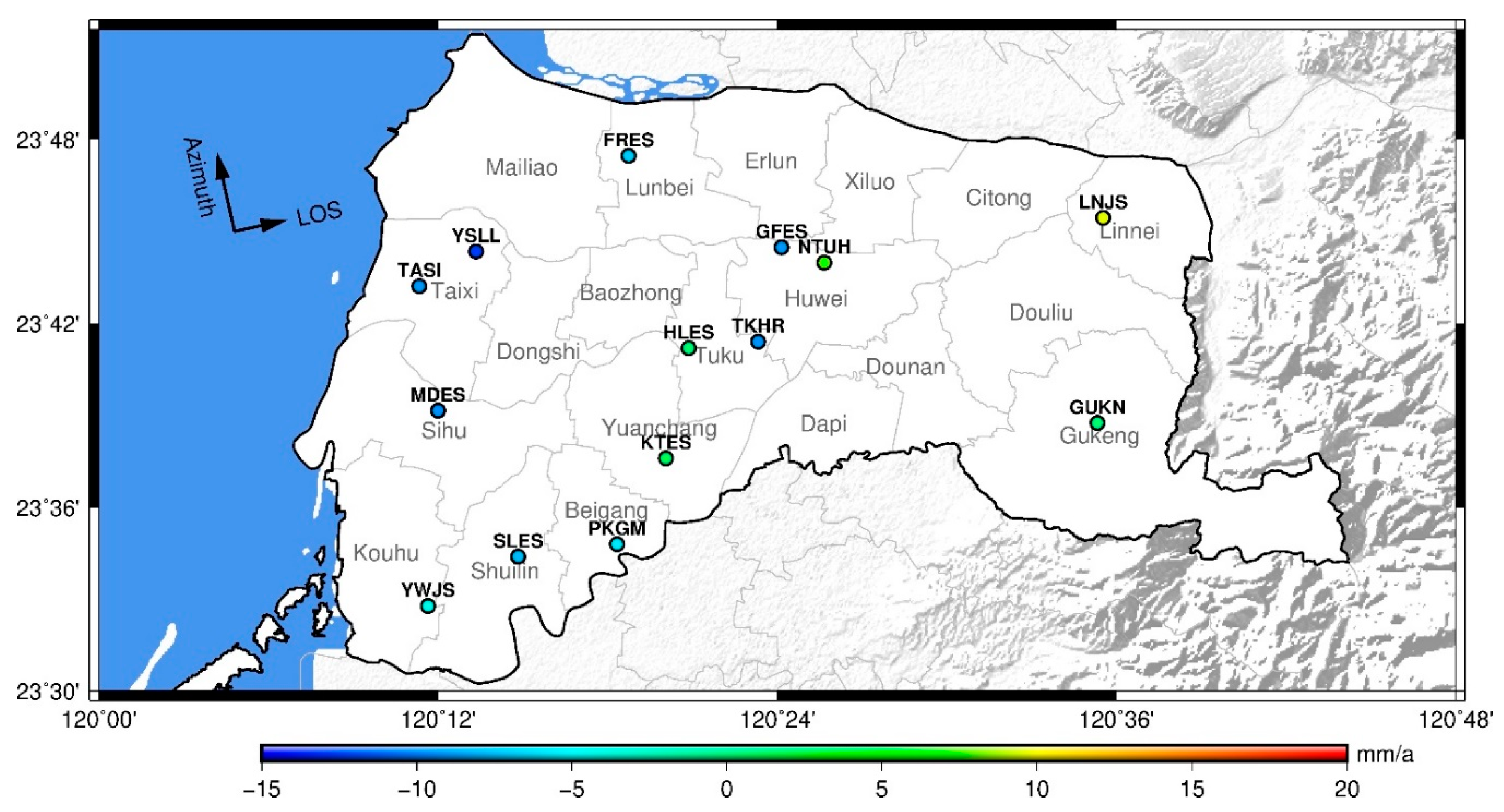

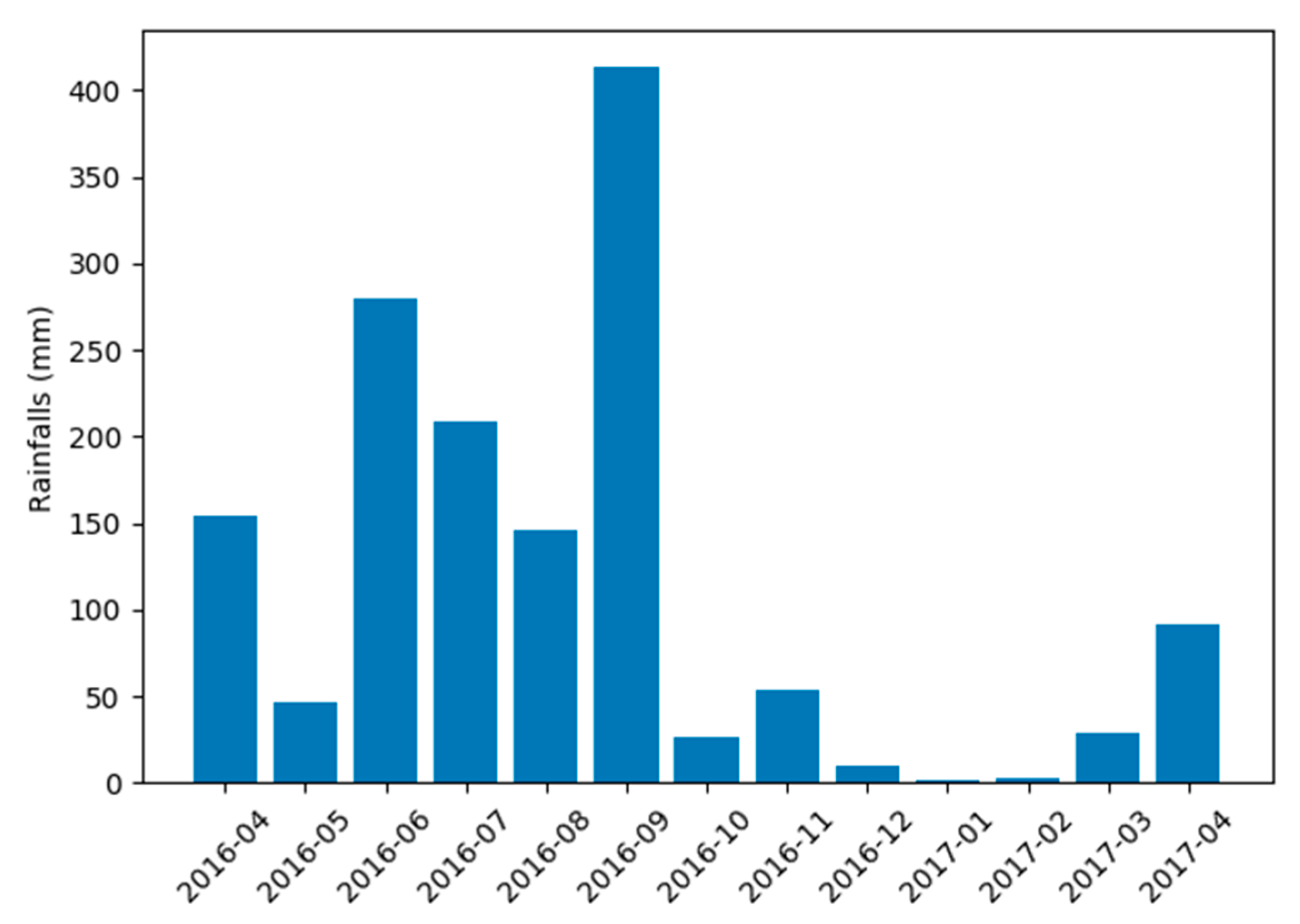

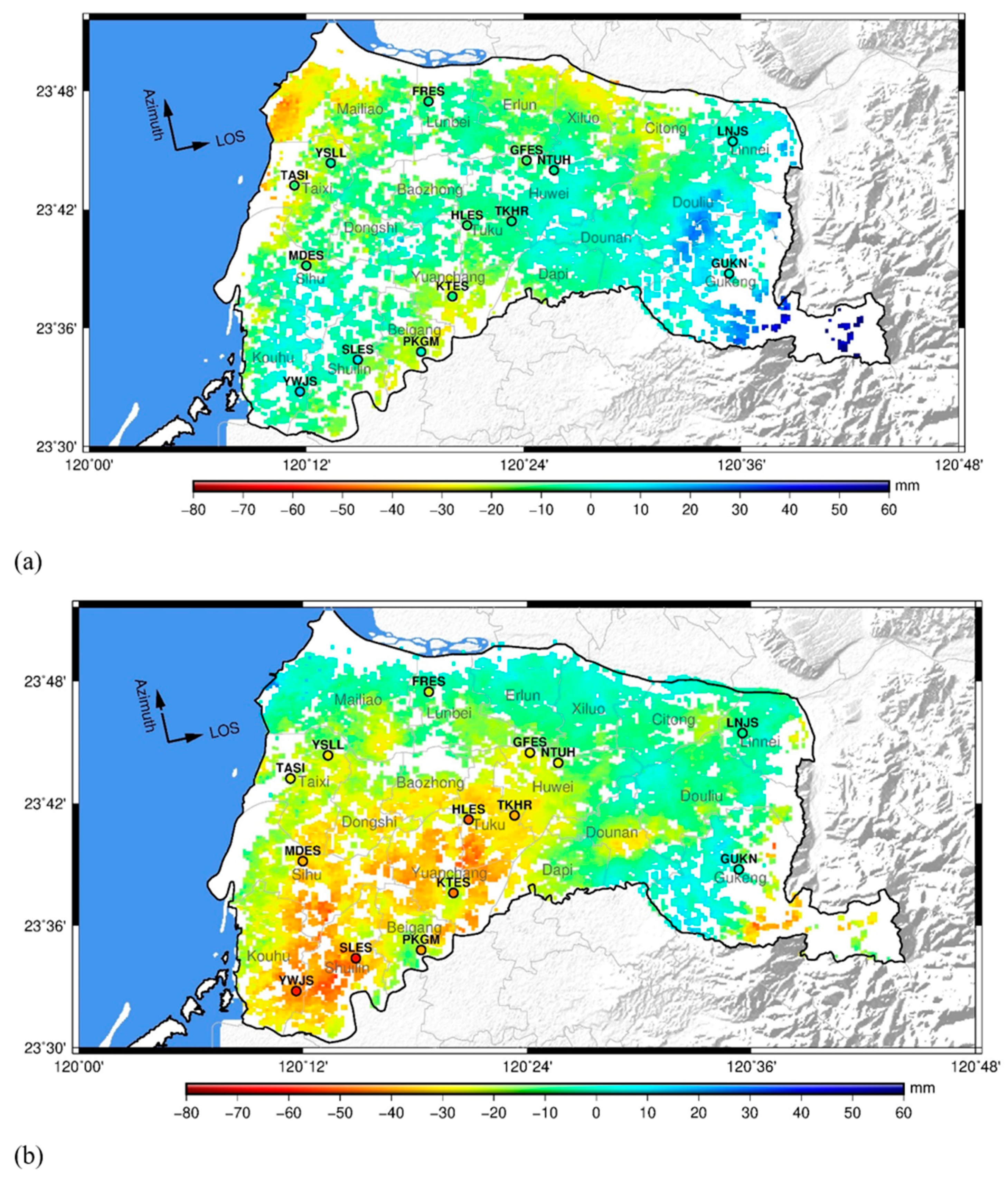
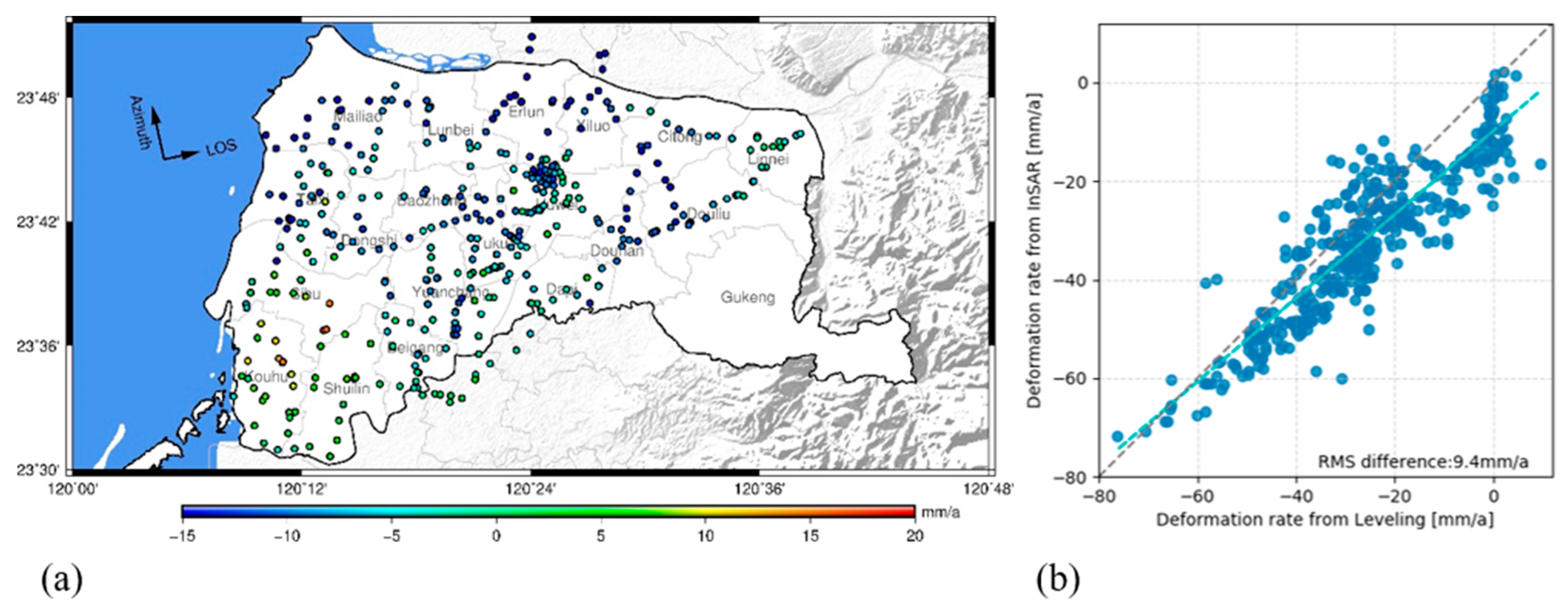
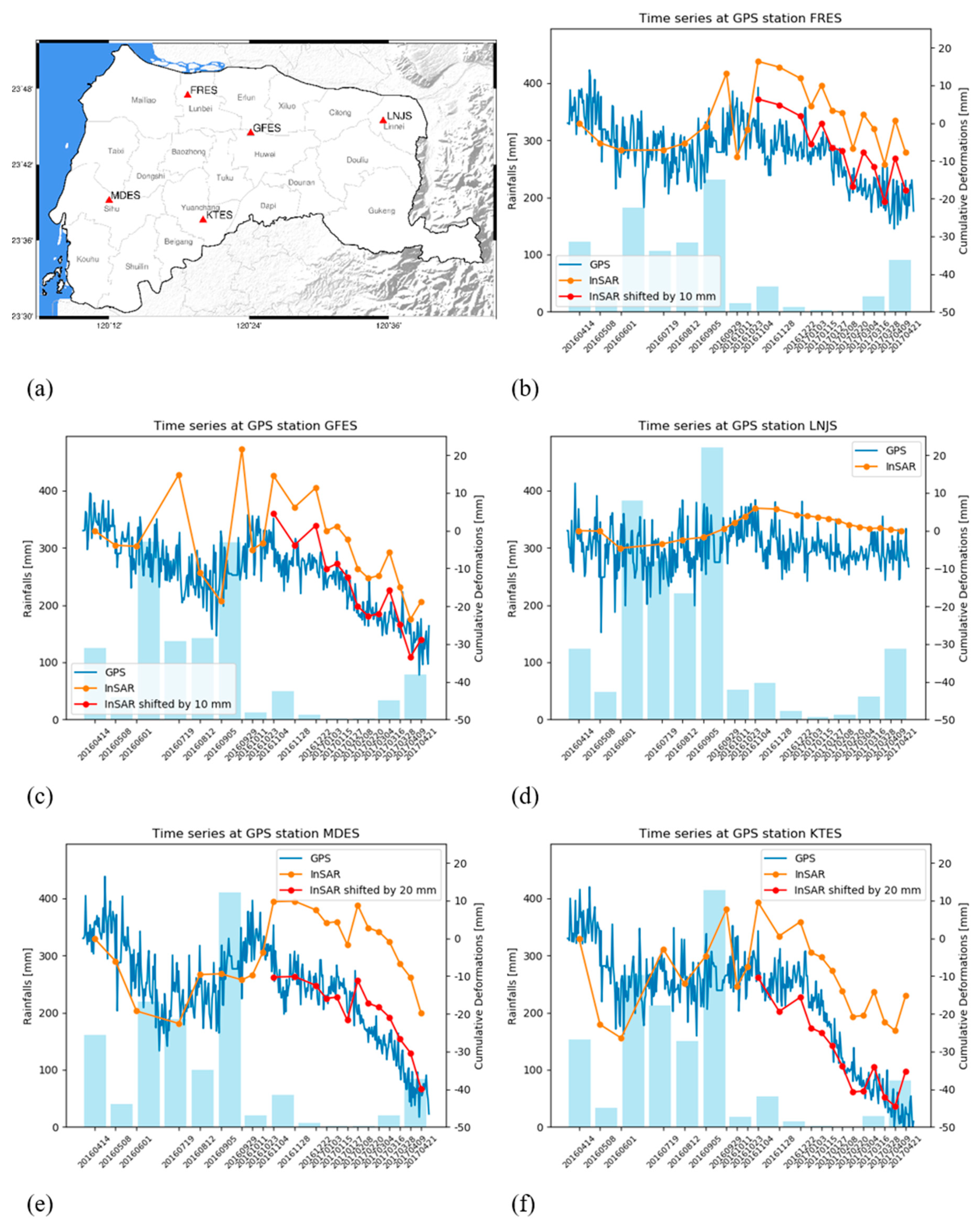
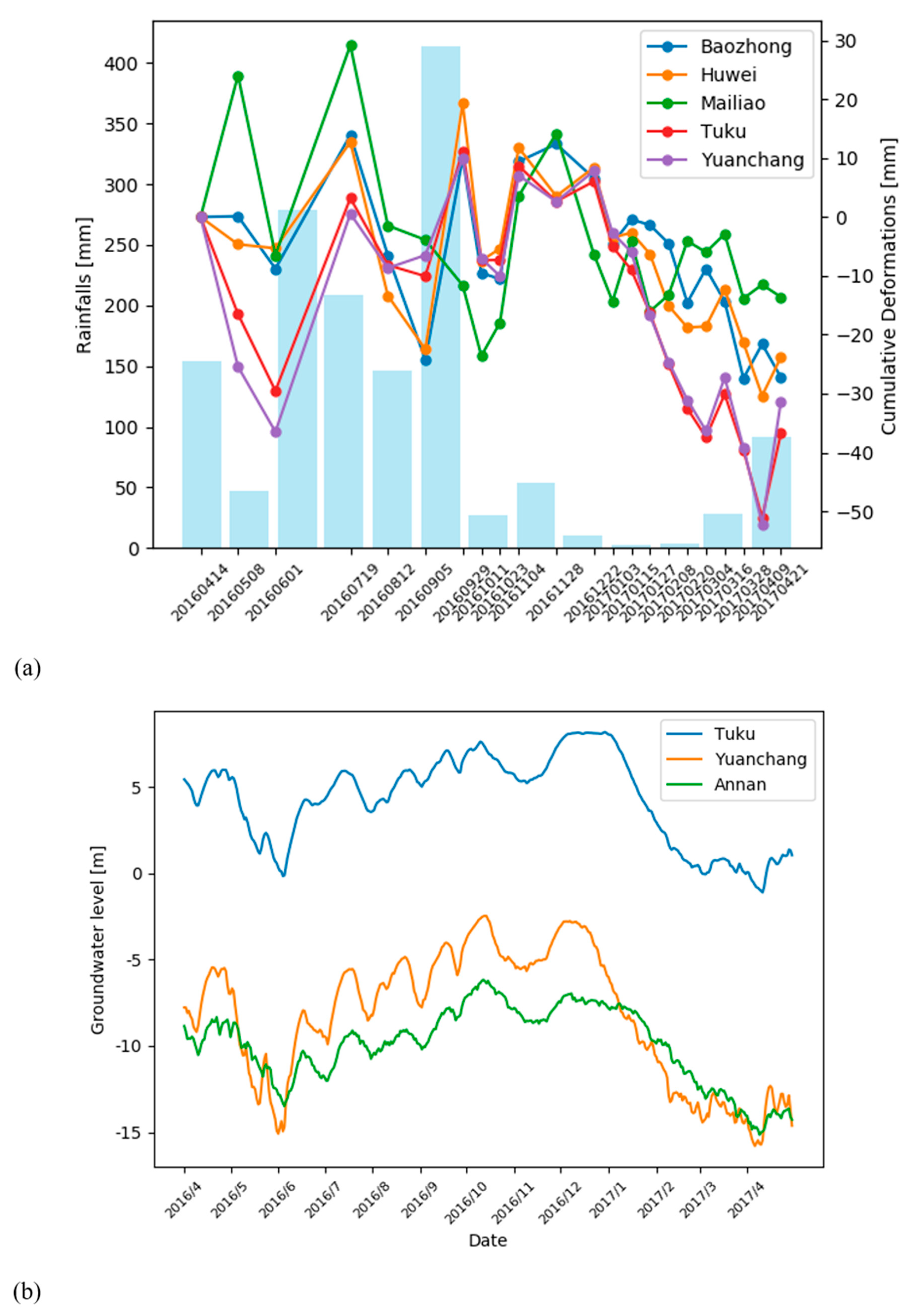



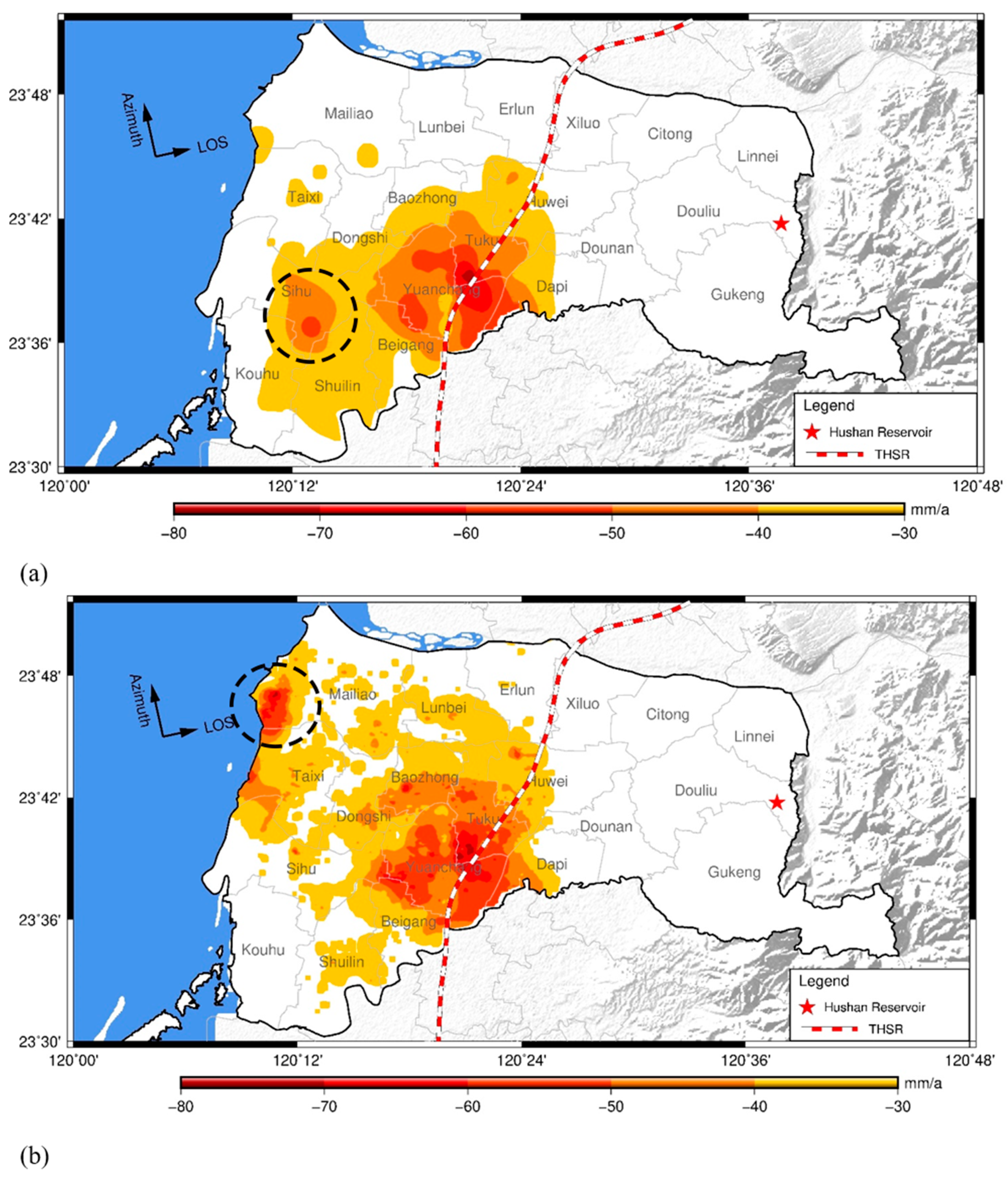
| Geometry | Scene No. | Date | Scene No. | Date |
|---|---|---|---|---|
| Ascending Track: 69 Frame: 74 | 1 | 04/14/2016 | 12 | 12/22/2016 |
| 2 | 05/08/2016 | 13 | 01/03/2017 | |
| 3 | 06/01/2016 | 14 | 01/15/2017 | |
| 4 | 07/19/2016 | 15 | 01/27/2017 | |
| 5 | 08/12/2016 | 16 | 02/08/2017 | |
| 6 | 09/05/2016 | 17 | 02/20/2017 | |
| 7 | 09/29/2016 | 18 | 03/04/2017 | |
| 8 | 10/11/2016 | 19 | 03/16/2017 | |
| 9 | 10/23/2016 | 20 | 03/28/2017 | |
| 10 | 11/04/2016 | 21 | 04/09/2017 | |
| 11 | 11/28/2016 | 22 | 04/21/2017 | |
| Descending Track: 105 Frame: 510 | 1 | 04/16/2016 | 8 | 12/12/2016 |
| 2 | 06/27/2016 | 9 | 01/05/2017 | |
| 3 | 07/21/2016 | 10 | 01/29/2017 | |
| 4 | 08/14/2016 | 11 | 02/22/2017 | |
| 5 | 09/07/2016 | 12 | 04/11/2017 | |
| 6 | 10/01/2016 | 13 | 04/23/2017 | |
| 7 | 11/18/2016 |
| Township | Wet Season | Dry Season | ||
|---|---|---|---|---|
| Cumulative Displacements (mm) | Ratio (%) | Cumulative Displacements (mm) | Ratio (%) | |
| Yuanchang | –16.97 | 27.52 | –44.70 | 72.48 |
| Tuku | –17.68 | 26.25 | –49.67 | 73.75 |
| Huwei | –18.44 | 37.22 | –31.11 | 62.78 |
| Baozhong | –18.12 | 39.23 | –28.07 | 60.77 |
| Mailiao | –44.26 | 80.94 | –10.42 | 19.06 |
| Subsidence Rates (mm/a) | Leveling (km2) | InSAR (km2) |
|---|---|---|
| 30–40 | 221.3325 | 215.5625 |
| 40–50 | 100.9125 | 98.0775 |
| 50–60 | 37.9300 | 61.325 |
| 60–70 | 9.2275 | 11.9975 |
| over 70 | 0.9575 | 1.1875 |
| Significant subsidence area | 370.36 | 388.15 |
© 2019 by the authors. Licensee MDPI, Basel, Switzerland. This article is an open access article distributed under the terms and conditions of the Creative Commons Attribution (CC BY) license (http://creativecommons.org/licenses/by/4.0/).
Share and Cite
Yang, Y.-J.; Hwang, C.; Hung, W.-C.; Fuhrmann, T.; Chen, Y.-A.; Wei, S.-H. Surface Deformation from Sentinel-1A InSAR: Relation to Seasonal Groundwater Extraction and Rainfall in Central Taiwan. Remote Sens. 2019, 11, 2817. https://doi.org/10.3390/rs11232817
Yang Y-J, Hwang C, Hung W-C, Fuhrmann T, Chen Y-A, Wei S-H. Surface Deformation from Sentinel-1A InSAR: Relation to Seasonal Groundwater Extraction and Rainfall in Central Taiwan. Remote Sensing. 2019; 11(23):2817. https://doi.org/10.3390/rs11232817
Chicago/Turabian StyleYang, Yi-Jie, Cheinway Hwang, Wei-Chia Hung, Thomas Fuhrmann, Yi-An Chen, and Shiang-Hung Wei. 2019. "Surface Deformation from Sentinel-1A InSAR: Relation to Seasonal Groundwater Extraction and Rainfall in Central Taiwan" Remote Sensing 11, no. 23: 2817. https://doi.org/10.3390/rs11232817
APA StyleYang, Y.-J., Hwang, C., Hung, W.-C., Fuhrmann, T., Chen, Y.-A., & Wei, S.-H. (2019). Surface Deformation from Sentinel-1A InSAR: Relation to Seasonal Groundwater Extraction and Rainfall in Central Taiwan. Remote Sensing, 11(23), 2817. https://doi.org/10.3390/rs11232817







